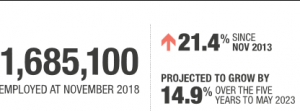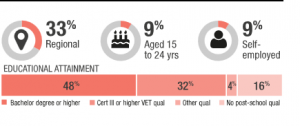Health Care and Social Assistance
Health Care and Social Assistance

https://australianjobs.employment.gov.au/jobs-industry/health-care-and-social-assistance

Aged and Disabled Carers
https://joboutlook.gov.au/Occupation?search=Career&code=4231
Health Care and Social Assistance is Australia’s largest and fastest growing industry, with a significant number of new jobs added over the past decade. Large shares of workers in this industry are employed as Professionals (42%) or Community and Personal Service Workers (31%). This industry has a relatively old workforce.
Post-school education is commonly required in this industry, and there has been a strong rise in the number of people studying Health. In 2017, there were 216,000 university enrolments in Health (almost doubling over the past decade) and 221,000 in the Vocational Educational and Training sector.
Health Care and Social Assistance is projected to have the strongest employment growth of any industry over the five years to May 2023, supported by the implementation of the National Disability Insurance Scheme and Australia’s ageing and growing population.
The number of people working as Aged and Disabled Carers (in their main job) grew very strongly over the past 5 years and is expected to grow very strongly over the next 5 years:
from 175,800 in 2018 to 245,000 by 2023.
Job openings can come from new jobs being created, but most come from turnover (workers leaving).
There are likely to be around 179,000 job openings over 5 years (that’s about 35,800 a year).
- Size: This is a very large occupation.
- Unemployment: Unemployment was below average in 2018.
- Location: Aged and Disabled Carers work in many regions of Australia.
- Industries: Most work in Health Care and Social Assistance; Public Administration and Safety; and Administrative and Support Services.
- Earnings: Full-time workers on an adult wage earn around $1,265 per week (below the average of $1,460). Earnings tend to be lower when starting out and higher as experience grows.
- Full-time: Less than half work full-time (33%, less than the average of 66%), showing there are many opportunities to work part-time.
- Hours: Full-time workers spend around 43 hours per week at work (compared to the average of 44 hours).
- Age: The average age is 47 years (compared to the average of 40 years). Many workers are 45 years or older (56%).
- Gender: 80% of workers are female (compared to the average of 48%).
Other Useful Sources
Deloitte Access Economics: ‘Australia’s Aged Care Sector: Economic Contribution and Future Directions’ (June 2016)
deloitte-au-australias-aged-care-sectoHealth Care and Social Assistancer-economic-contribution-010616deloitte-au-
australias-aged-care-sector-economic-contribution-010616
University of Southern Queensland ‘The Future of Counselling Report: Career Prospects and Trends’ (September 2017)
Counselling Career Prospects and Trends Report_final for web